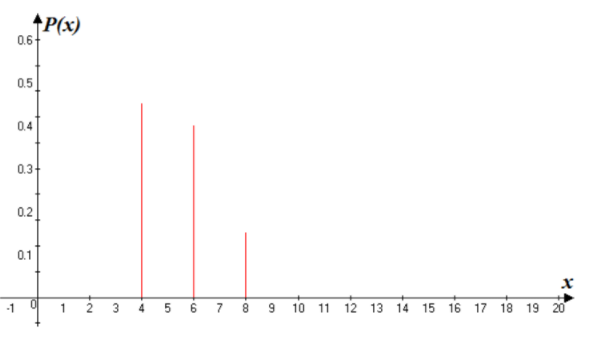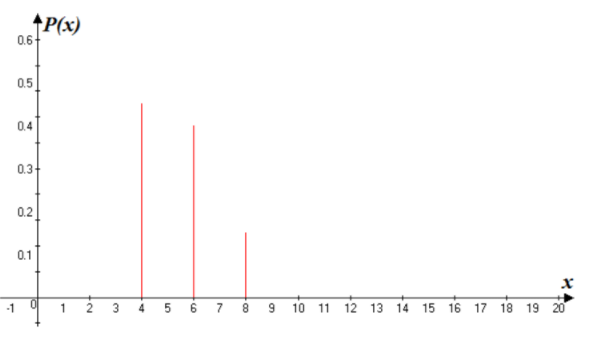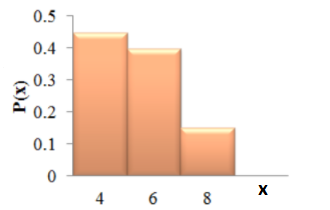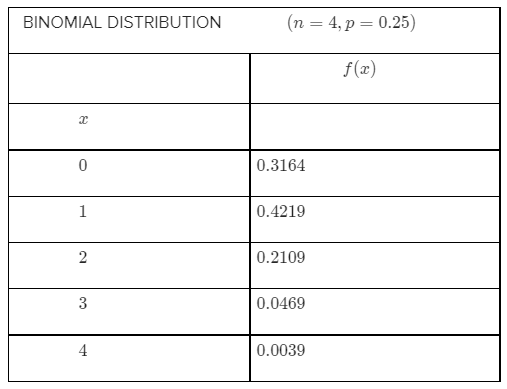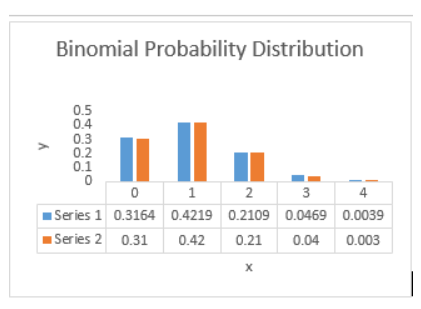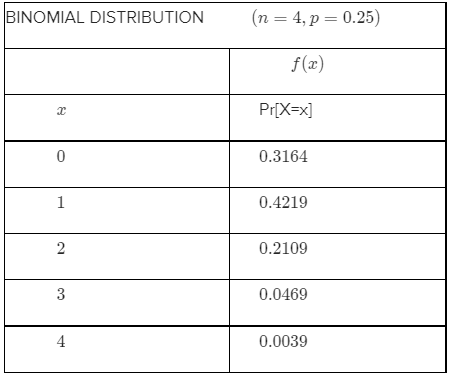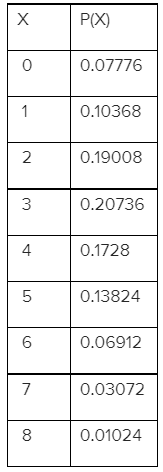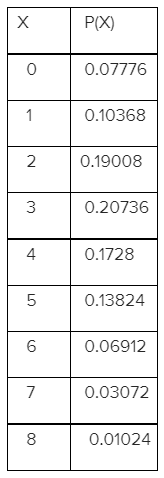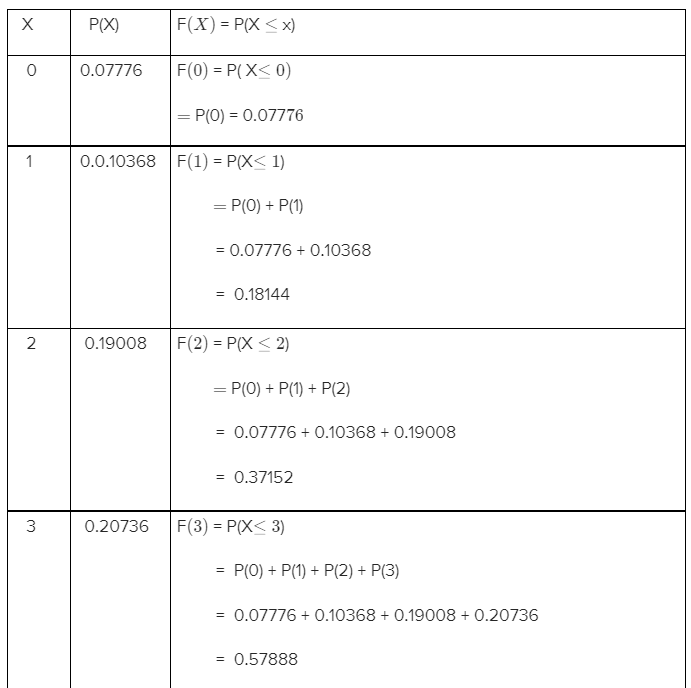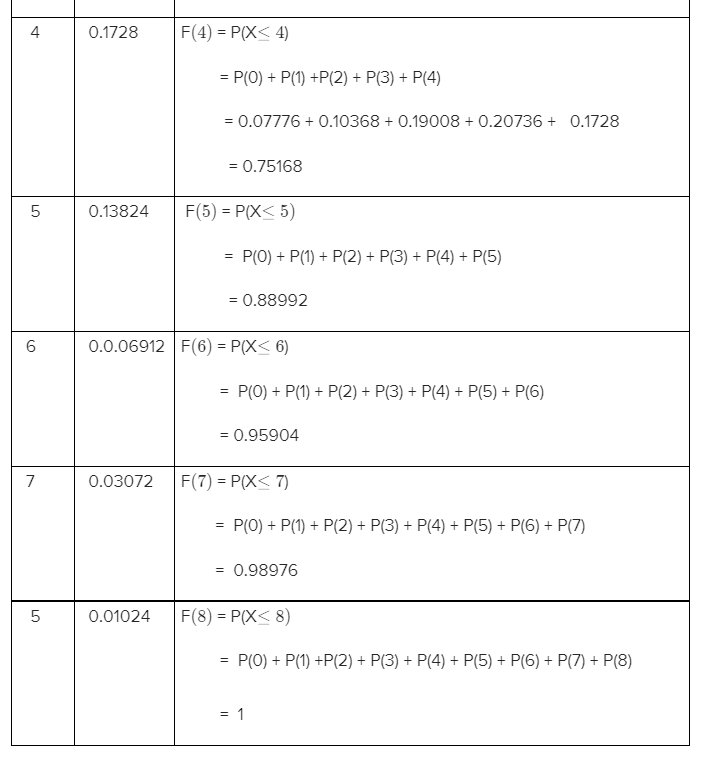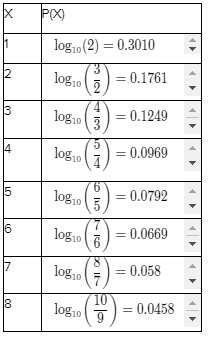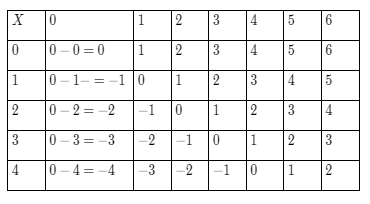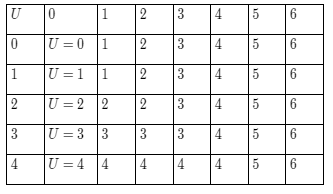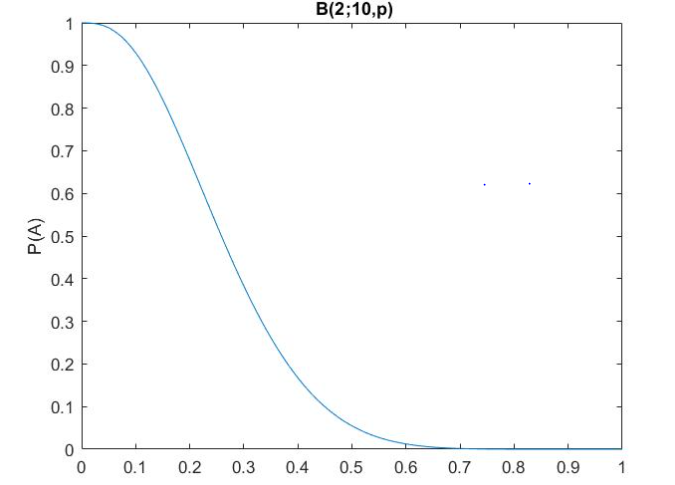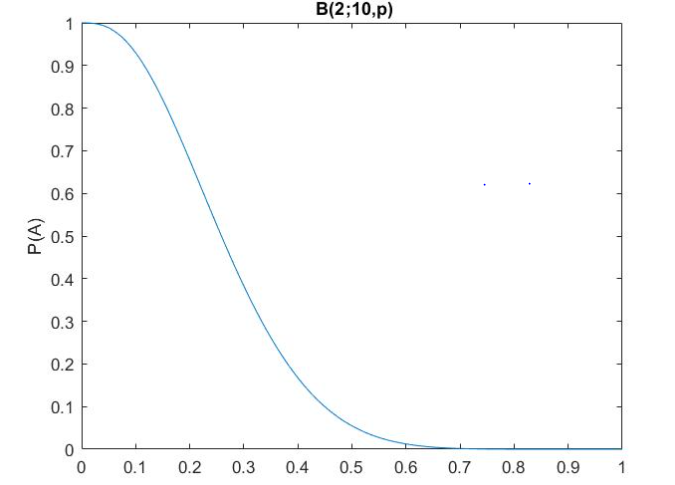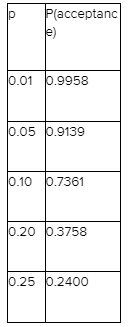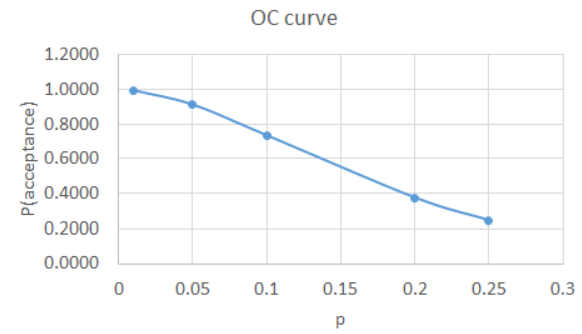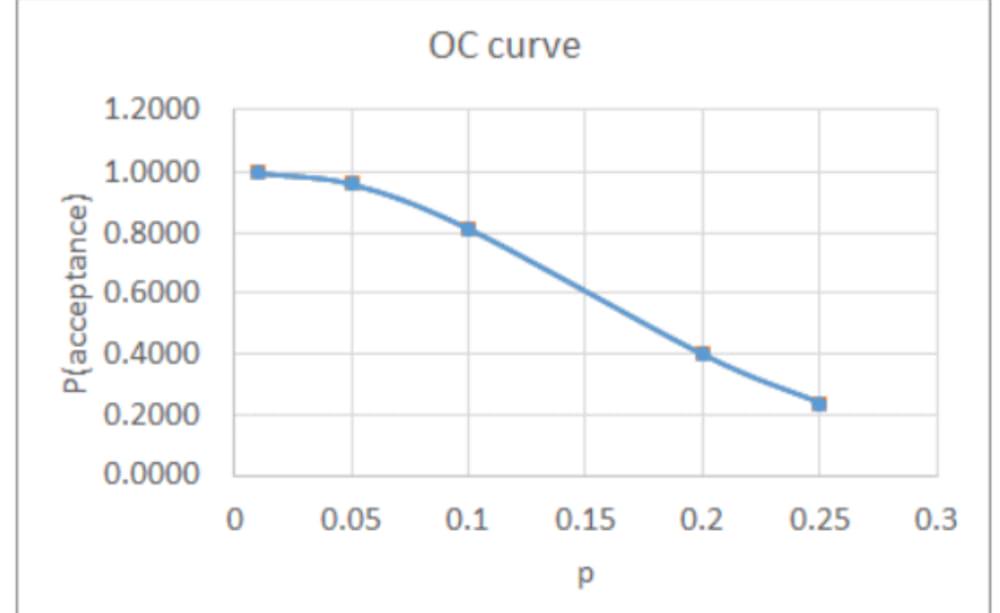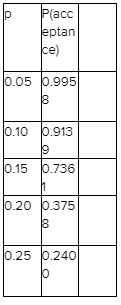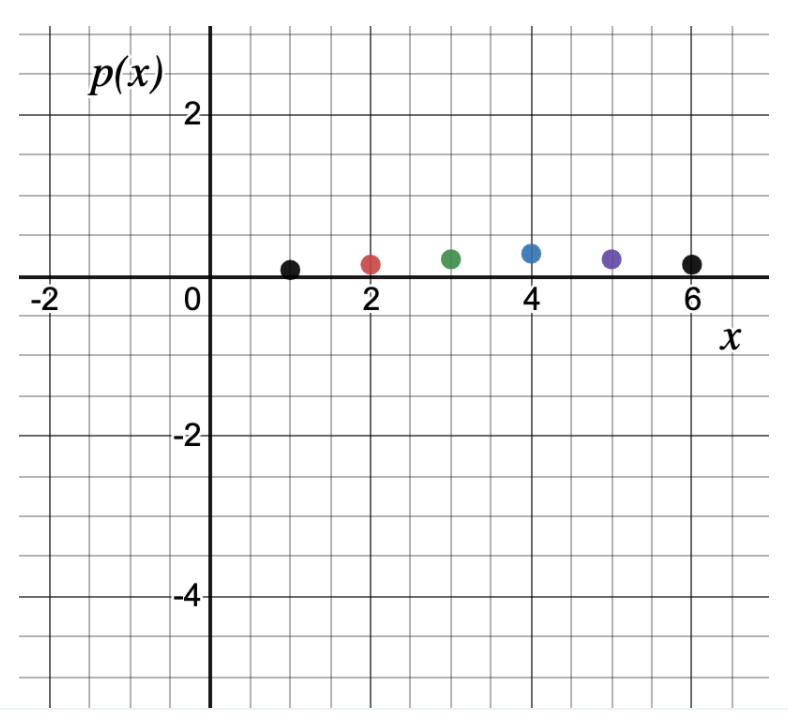Probability and Statistics for Engineering and the Sciences 8th Edition Chapter 2 Probability
Page 86 Problem 1 Answer
Given: Random student is selected from a university.
Given: A={ Visa } .
B={ MasterCard }
Given: P(A)=0.5
P(B)=0.4
P(A∩B)=0.25
To show that A and B are dependent by using the definition of independence.
To verify that the multiplication property does not hold.We will have to show that: P(A∣B)≠P(A) and P(A∩B)≠P(A)⋅P(B)
Firstly, we will find P(A∣B) with the definition of conditional probability.
P(A∣B)=P(A∩B)/P(B)
=0.3/0.4
=0.75
Also, we are given P(A)=0.6.
We clearly see that 0.75=P(A∣B)≠P(A)=0.6
Hence, events A and B are dependent.
We will verify this by using multiplication rule.
We know that if the two events are independent then they will satisfy P(A∩B)=P(A)⋅P(B)
From the given data, we see, P(A∩B)=0.3;P(A)⋅P(B)=0.6⋅0.4
=0.24
Thus, we get P(A∩B)≠P(A)⋅P(B)
∴It is verified that these two events are independent.
We have shown that the events A and B are dependent and that the multiplication property does not hold.
Page 86 Problem 2 Answer
Given: An oil exploration company currently has two active projects, one in Asia and the other in Europe.
Let A be the event that the Asian project is successful and B be the event that the European project is successful.
Given: A and B are independent events with P(A)=0.4 and P(B)=0.7
To find the probability that the European project is not successful given that the Asian project is not successful.
We will use the above stated propositions to find the probability.
A and B are given to be independent.
Now, using above preposition we know that A′ and B′ are also independent.
We will now find the conditional probability of B′ and given that the event A′ has occurred and is denoted by P(B′∣A′).
Here, event B′ is European project is successful and event A′ is the Asian project is not successful.
if P(A∣B)=P(A) ,where A and B are the two events then this implies that they are independent.
Now, P(B′∣A′)=P(B′)
=1−P(B)
=1−0.7
=0.3
The probability that the European project is also not successful given that the Asian project is not successful is : P(B′∣A′)=0.3
Page 86 Problem 3 Answer
Given: An oil exploration company currently has two active projects, one in Asia and the other in Europe.
Let A be the event that the Asian project is successful and B be the event that the European project is successful.
Given: A and B are independent events with P(A)=0.4 andP(B)=0.7
To find the probability that at least one of the two projects will be successful.
We will use the property P(A∪B)=P(A)+P(B)−P(A∩B)
The probability that at least one of the two projects will be successful is :
P(A∪B)=P(A)+P(B)−P(A∩B)
=0.4+0.7−0.4⋅0.7
=0.82
From the above preposition when two sets A and B are independent then :
P(A∩B)=P(A)⋅P(B)
=0.4⋅0.7
=0.28
The probability that at least one of the two projects will be successful is :P(A∪B)=0.82.
Page 86 Problem 4 Answer
Given: An oil exploration company currently has two active projects, one in Asia and the other in Europe.
Let A be the event that the Asian project is successful and B be the event that the European project is successful.
Given: A and B are independent events with P(A)=0.4 and P(B)=0.7
To find the probability only the Asian project is successful given that at least one of the two is successful.
We will use conditional probability P(A∣B)=P(A∩B)
P(B) where P(B)>0
We have A and B are independent which implies that A and B′ are independent.
A∩B′ is the event only the Asian project is successful.
Now, we will find the conditional probability of A∪B given that the event A∩B′ has occurred is denoted by P(A∩B′∣A∪B).
P(A∩B′∣A∪B)=P[(A∩B′)∩(A∪B)]/P(A∪B)
=P(A∩B′)/P(A∪B)
=P(A)⋅P(B′)/P(A∪B)
=0.4⋅(1−0.7)/0.82
=0.146
The probability that only the Asian project is successful is :P(A∩B′∣A∪B)=0.146
Page 86 Problem 5 Answer
Given: A and B events are independent.To show that events A′ and B are independent.
We will show that: P(A′∣B)=P(A′)
To prove that event A′ and B are independent.
Using conditional probability we have,
P(A′∣B)=P(A′∩B)/P(B) [Now using, P(B)=P[(A′∩B)∪(A∩B)]=P(A′∩B)+P(A∩B)
That is P(A′∩B)=P(B)−P(A∩B)]
=P(B)−P(A∩B)/P(B) [Now using multiplication property where events A and B are independent.]
=P(B)−P(A)P(B)/P(B)
=P(B)(1−P(A))/P(B) [Now, for any event C we know that P(C)+P(C′)=1 .]
=1−P(A)
=P(A′)
Hence we get: P(A′∣B)=P(A′)
Therefore events A′ and B are independent.
We have shown that the events A′ and B are independent if A and B are independent.
Page 87 Problem 6 Answer
Given: One of the assumptions underlying the theory of control charting is that successive plotted points are independent of one another.
Each plotted point can signal either that a manufacturing process is operating correctly or that there is some sort of malfunction.
Given: The probability that a particular point will signal a problem with the process is 0.5.
To find the probability that at least one of 10 successive points indicates a problem when in fact the process is operating correctly.
To find the probability for 25 successive points.
We will use multiplication property for independent events and the fact that if A and B are independent then A′ and B′are also independent events.
Let us denote the event as :Ai={ point i error was signaled incorrectly }
where i=1,2,…,25
The probability of each of the event is given 0.05 is same for all events.
Now, the probability that at least one of 10 successive points indicates a problem when in fact the process is operating correctly is denoted as the union of the events A1,A2,…,A10.
Now, using De Morgan’s Law we have :
P(A1∪A2∪…∪A10)=P[(A1′∩A2′∩…∩A10′)′]
[Now, using the property when A be an event P(A′)+P(A)=1 ]
=1−P(A1′∩A2′∩…∩A10′) [Now using multiplication property]
=1−P(A1′)⋅P(A2′)⋯…P(A10′)∣ [Again using P(A′)+P(A)=1]
=1−(1−0.05)⋅(1−0.05)⋅…⋅(1−0.05)
=1−0.9510
=0.401
Similarly for 25 successive points we get :
P(A1∪A2∪…∪A25)=P[(A1′∩A2′∩…∩A25′)′]
=1−P(A1′∩A2′∩…∩A25′)
=1−P(A1′)⋅P(A2′)⋯…P(A25′)
=1−(1−0.05)⋅(1−0.05)⋅…(1−0.05)
=1−0.9525
=0.723.
The probability that at least one of 10 successive points indicates a problem when in fact the process is operating correctly is 0.401.
The probability for 25 successive points is 0.723.
Page 87 Problem 7 Answer
Given: In October, 1994, a flaw in a certain Pentium chip installed in computers was discovered that could result in a wrong answer when performing a division.
The manufacturer initially claimed that the chance of any particular division being incorrect was only 1 in 9 billion, so that it would take thousands of years before a typical user encountered a mistake.
However, statisticians are not typical users; some modern statistical techniques are so computationally intensive that a billion divisions over a short time period is not outside the realm of possibility.
Given that the 1 in 9 billion figure is correct and that results of different divisions are independent of one another.
To find the probability that at least one error occurs in one billion divisions with the chip.
We will use multiplication of independent events and the fact that if A and B are independent then A′ and B′ are also independent.
We will denote the event as :
Denote event A={ the division is incorrect }.
And the probability of event A is given as P(A)=0.0000000009
And the probability of the same of one in nine billion is :
P(A)=1/9,000,000,000
=a
Now, we have assume that we have one billion divisions with the same chip.
Let us denote this event as Ai={ the ith division is incorrect } , from i=1 to billion, where (i=1,2,…,109) .
Now, the probability that at least one error occurs in one billion divisions with this chip is the union of the billion Ai events is :
Using De Morgan’s Law,
P(A1∪A2∪…∪A109)=P[(A1′∩A2′∩…∩A109′)′
=1−P(A1′∩A2′∩…∩A109′)
=1−P(A1′)⋅P(A2′)⋯⋅⋅P(A109′)
=1−(1−a)⋅(1−a)⋅…⋅(1−a)
=1−0.895
=0.105
The probability that at least one error occurs in one billion divisions with the chip is 0.105
Page 87 Problem 8 Answer
Given: An aircraft seam requires 25 rivets.
The seam will have to be reworked if any of these rivets is defective.
Suppose rivets are defective independently of one another, each with the same probability.
To find the probability that a rivet is defective if 20% of all seams need reworking.
We will use the multiplicative property of independent events.
Given that an aircraft seam requires 25 rivets.
Let us consider the probability that a rivet is defected is p.
Now, let us consider the probability that a rivet is not defected is 1−p
And it is given that the rivets are defective independently of one another, each with the same probability.
The probability that the seam is to be reworked is :
P( reworked )=1−P( not reworked )
=1−P( all 25 rivets are non−defective )
=1−[P( rivet is non−defective )]25
( Since defective probabilities are independent )
P( reworked )=1−[(1−p)25]
P( reworked )=0.2 is given then:
0.2(1−p)25/1−p
p=1−(1−p)25
=0.8
=25/√0.8
=0.0088.
⇒p≈0.009
The probability that a rivet is defective if 20% of all seams need reworking is 0.009
Page 87 Problem 9 Answer
Given: An aircraft seam requires 25 rivets.
The seam will have to be reworked if any of these rivets is defective.
Suppose rivets are defective independently of one another, each with the same probability.
To find how small the probability of a defective rivet should be to ensure that only 10% of all seams need reworking.
We will use the multiplicative property of independent events
Given that an aircraft seam requires 25 rivets…
Let us consider the probability that a rivet is defected is p.
Now, let us consider the probability that a rivet is not defected is 1−p.
And it is given that the rivets are defective independently of one another, each with the same probability.
The probability of a defective rivet be to ensure that only 10% of all seams need reworking is :
P( reworked )=1−∣(1−p)25∣
⇒0.10=1−[(1−p)]{25}
⇒[1−p]25
=1−0.10
⇒(1−p)=0.901/25
⇒p=1−0.90{1/25}
⇒p=1−0.99579
p=0.00421
The probability of a defective rivet should be 0.00421 to ensure that only 10% of all seams need reworking.
Page 87 Problem 10 Answer
Given: A boiler has five identical relief valves.
Given: The probability that any particular valve will open on demand is 0.96.
To assume independent operation of the valves and find P(at least one valve opens) and P(at least one valve fails to open).
We will multiplication rule on independent events and the fact that if two events are independent then their complements are also independent events.
Lets us consider the event A be that at least one valve open and event B be that at least one valve fails to open.
And let Vi be the events that i th valve open.
We have P(A)=1−P(A′) Where event A′ be that has no valve opens. Now, the probability of A′is :
P(A′)=P(V1′∩V2′∩V3′∩V4′∩V5′)
Now, using the multiplication rule we have :
P(A′)=P(V1′∩V2′∩V3′∩V4′∩V5′)=P(V1′)⋅P(V2′)⋅P(V3′)⋅P(V4′)⋅P(V5′)
=[P(Vi′)]5
=[1−P(Vi)]5
=[1−0.95]{5}
=[0.05]{5}
=0.0000003125
Now, the probability that at least one valve open is :
P(A)=1−P(A′)
=1−(0.0000003125)
=0.99999969
≈0.9999
Now, we have P(B)=1−P(B′) where event B′ is that all valves open.
Now, the probability of B′is :
P(B′)=P(V1∩V2∩V3∩V4∩V5)
The probability that at least one valve fails to open is P(B)=1−P(B′)
By using multiplication rule,
P(B′)=P(V1∩V2∩V3∩V4∩V5)
=P(V1)⋅P(V2)⋅P(V3)⋅P(V4)⋅P(V5)
=[P(Vi)]5
=0.95{5}
=0.7737
Now, P(B)=1−P(B′)
=1−(0.774)
=0.2262
The probability that at least one valve opens is 0.9999. The probability that at least one valve fails to open is0.2262
Page 87 Problem 11 Answer
Given: Two pumps connected in parallel fail independently of one another on any given day.
Given: The probability that only the older pump will fail is 0.10, and the probability that only the newer pump will fail is 0.05.
To find the probability that the pumping system will fail on any given day (which happens if both pumps fail).
Let us denote the events as :
A={ older pump fails }
B={ newer pump fails }
Now, the probabilities are given :
P(A∩B′)=P(A)−P(A∩B)
=0.1/P(B∩A′)=P(B)−P(A∩B)
=0.05
Now, lets consider x=P(A∩B) , then
P(A)=0.1+x and
P(B)=0.05+x
Now, using the multiplication property we have :
P(A∩B)=P(A)⋅P(B)
=(0.1+x)⋅(0.05+x)
The quadratic equations will be :
x=0.005+0.1⋅x+0.05⋅x+x2/x2−0.85⋅x+0.005=0
Now, the roots of this quadratic equation is :
x12=−b±√b2−4ac/2a
=0.85±√0.852−4⋅1⋅0.005/2⋅1
x1=0.85+√0.852−4⋅0.005/2
x{1}=0.8441
x2=0.85−√0.852−4⋅0.005/2
x{2}=0.0059.
We have P(A∪B)=P(A)+P(B)−P(A∩B).
Lets assume x1 is true then :
P(A∪B)=0.1+0.8441+0.05+0.8441−0.8441
P(A∪B)=0.9941
Now, lets assume x2is true then :
P(A∪B)=0.1+0.0059+0.05+0.0059−0.0059
P(A∪B)=0.1559
Both are the possible solutions.
If x1 is true then we have P(A∪B)>1 which is not possible.x2 is only possible solution.
The probability that the pumping system will fail on any given day (which happens if both pumps fail) is 0.0059.
Page 87 Problem 12 Answer
Given: Consider the system of components connected as in the accompanying picture.
Components 1 and 2 are connected in parallel, so that subsystem works iff either 1 or 2 works; since 3 and 4 are connected in series, that subsystem works iff both 3 and 4 work.
Given figure:

To find probability that the system works given that components work independently of one another.
We will use the multiplication property for independent events.
The given components are independent.
Their probability is :P( component 1 works )=0.9
P( component 2 works )=0.9
P( component 3 works )=0.8
P( component 4 works )=0.8
Now, using the multiplication rule :
P( component 1 and 2 work )=P( component 1 works )×P( component 2 works )
=0.9⋅0.9
=0.81
Now, using the general addition rule for any two events –
If component 1 or component 2 works then the top subsystem works that is :
P( top subsystem works )=P( component 1 works )+P( component 2 works )−P( component 1 and 2 work )
=0.9+0.9−0.81
=0.99
Similarly, if both components 3 and component 4 works then the bottom subsystem works that is :
P( bottom subsystem works )=P( component 3 works )×P( component 4 works )
=0.8⋅0.8
=0.64
Each component is given independent which implies that the two subsystems are independent.
Using the multiplication rule for independent events we get :
P (both subsystems work) =P (top subsystem works) ×P (bottom subsystem works)
=0.99×0.64
=0.6336
When the top subsystem works or the bottom subsystem works then the system will work.
P( system works )=P( top subsystem works )+P( bottom subsystem works )−P( both subsystems work )
=0.99+0.64−0.6336
=0.9964
=99.64%
The probability that system works : P(system works) is 0.9964.
Page 87 Problem 13 Answer
Given: Components arriving at a distributor are checked for defects by two different inspectors (each component is checked by both inspectors).
The first inspector detects 90% of all defectives that are present, and the second inspector does likewise.
Given: At least one inspector does not detect a defect on 20% of all defective components.
To find the probability that a defective component will be detected only by the first inspector.
To find the probability that a defective component will be detected only by exactly one of the two inspectors.We will use the property P(A′)+P(A)=1
Let us denoted the events as :
A1={ first inspector detects }
A2={ second inspector detects}
And the probabilities of the above events are given as :
P(A1)=0.9
P(A2)=0.9
The probability that at least one inspector does not detect a defect is the union of the events A1′ and A2′ is given to be :
P(A1′∪A2′)=0.2
From the above given probability we can obtain :
P(A1∩A2)=1−P[(A1∩A2)′]
Now, using the property P(A′)+P(A)=1
we get :=1−P(A1′∪A2′)
=1−0.2
=0.8
Now, the probability of event A1 intersection event A2 is :
P(A1∩A2′)=P(A1)−P(A1∩A2)
=0.9−0.8
=0.1
Now, the probability that one of the two inspectors detect is the sum of the probability we just calculate above and the probability that a defective component will be detected only by the second inspector is :
P(A1′∩A2)=P(A2′)−P(A1∩A2)
=0.9−0.8
=0.1
Now, we will define an event C as:C={ exactly one inspector detects }
And the probability of the event C is:
P(C)=P(A1∩A2′)+P(A1′∩A2)
=0.1+0.1
=0.2
The probability that a defective component will be detected only by the first inspector isP(A1
∩A2′)=0.1 .The probability that a defective component will be detected by exactly one of the two inspectors is P(C)=0.2.
Page 87 Problem 14 Answer
Given: Components arriving at a distributor are checked for defects by two different inspectors (each component is checked by both inspectors).
The first inspector detects 90% of all defectives that are present, and the second inspector does likewise.
Given: At least one inspector does not detect a defect on 20%of all defective components.
To find the probability that all three defective components in a batch escape detection by both inspectors.
We will use the multiplication of independent events.
Let us denoted the events as :
A1={ first inspector detects }
A2={ second inspector detects }
And the probabilities of the above events are given as :
P(A1)=0.9
P(A2)=0.9
The probability that at least one inspector does not detect a defect is the union of the events A1′and A2′ is given to be :
P(A1′∪A2′)=0.2
From the above given probability we can obtain :
P(A1∩A2)=1−P∣∣(A1∩A2)′∣∣
Now using the property P(A′)+P(A)=1
we get :
=1−P(A1′∪A2′)
=1−0.2
=0.8
The probability that neither of inspectors detect a defect is the complement of union of events A1 and A2 is : ( from part )
Using identity P(A)+P(A′)=1 we have,
P[(A1∪A2)′]=1−P(A1∪A2)
The union of two events can always be represented as the sum of these three events. So, we have
=1−[P(A1∩A2)+P(C)](P(C) from part (a) )
=1−0.8−0.2
=0
Now we consider an event A3 which is denoted as :
A3={ all three defective components escape detection }
Now, the probability of event A3 is :
Using multiplication property we have,
P(A3)=P[(A1∪A2)′]⋅P[(A1∪A2)′∣⋅P[(A1∪A2)′]
=0⋅0⋅0
=0
The probability that all three defective components in a batch escape detection by both inspectors is : P(A3)=0
Page 87 Problem 15 Answer
Given: Seventy percent of all vehicles examined at a certain emissions inspection station pass the inspection.
Given: Successive vehicles pass or fail independently of one another.
To calculate the probability: P(all of the next three vehicles inspected pass)We will use the multiplication rule for independent events.
We have: P( Pass )=0.7
Now we are given that the successive events are independent, hence we can apply multiplicative rule of multiplication for independent evets.
Therefore we get:
P( All three pass )
=P( Pass )×P( Pass )×P( Pass )
=0.7×0.7×0.7
=0.343
=34.3%
We obtain: P(all of the next three vehicles inspected pass)=0.343
Page 87 Problem 16 Answer
Given: Seventy percent of all vehicles examined at a certain emissions inspection station pass the inspection.
Given: Successive vehicles pass or fail independently of one another.
To calculate the probability : P(at least one of the next three inspected fails)We will use the complement rule to calculate.
We have obtained in part a)
P (all of the next three vehicles inspected pass) =0.343
Hence by using complement rule we get:
P( At least one fail )
=1−P( All three pass )
=1−0.343
=0.657
=65.7%
We obtain: P(at least one of the next three inspected fails)=0.657
Page 87 Problem 17 Answer
Given: Seventy percent of all vehicles examined at a certain emissions inspection station pass the inspection.
Given: Successive vehicles pass or fail independently of one another.
To calculate: P(exactly one of the next three inspected passes)We will use complement rule to calculate.
We have: P( Pass )=0.7 by using complement rule we get: P( Fail )
=1−P( Pass )
=1−0.7
=0.3
We are given that the events are independent.
Hence by using the multiplicative rule for independent events we get:
P( Exactly one pass )
=3×P( Pass )×P( Fail )×P( Fail )
=3×0.7×0.3×0.3
=0.189
We obtain: P(exactly one of the next three inspected passes)=0.189
Page 87 Problem 18 Answer
Given: Seventy percent of all vehicles examined at a certain emissions inspection station pass the inspection.
Given: Successive vehicles pass or fail independently of one another.
To calculate: P(at most one of the next three vehicles inspected passes)We will use addition rule for mutually exclusive events.
We have obtained in part c) that: P( Fail )=0.3
The events are independent.
Hence by using the multiplication rule:
P( None pass )
=P( Fail )×P( Fail )×P( Fail )
=0.3×0.3×0.3
=0.027
We know from c that: P (exactly one of the next three inspected passes) =0.189
At most one vehicle passes when none of the vehicle passes OR exactly one vehicle passes.
These events are mutually exclusive hence we have: P( At most one pass )
=P( None pass )+P( Exactly one pass )
=0.027+0.189
=0.216
We obtain: P(at most one of the next three vehicles inspected passes)=0.216.
Page 87 Problem 19 Answer
Given: Seventy percent of all vehicles examined at a certain emissions inspection station pass the inspection.
Given: Successive vehicles pass or fail independently of one another.
To find the probability all three vehicles pass given that at least one of the next three vehicles passes inspection.
We will use conditional probability formula: P(B∣A)=P(A∩B)
P(A),P(A)>0
From d) we have that: P( None pass )=0.027
Hence using complement rule we get:
P( At least one pass )
=1−P( None pass )
=1−0.027
=0.973
Now using conditional probability we get:
P( All three pass ∣ At least one pass )
=P( All three pass and At least one pass /P( At least one pass )
=P( All three pass )/P( At least one pass )
=0.343/0.973
⇒P ( All three pass ∣ At least one pass )=0.3525
The probability all three vehicles pass given that at least one of the next three vehicles passes inspection is 0.3525.
Page 88 Problem 20 Answer
Given: Professor Stan der Deviation can take one of two routes on his way home from work.
On the first route, there are four railroad crossings.
The probability that he will be stopped by a train at any particular one of the crossings is 0.1, and trains operate independently at the four crossings.
The other route is longer but there are only two crossings, independent of one another, with the same stoppage probability for each as on the first route.
On a particular day, Professor Deviation has a meeting scheduled at home for a certain time.
Whichever route he takes, he calculates that he will be late if he is stopped by trains at at least half the crossings encountered.
To determine which route to take so that he can minimize the probability of being late to the meeting.
We will use the probability mass function of binomial random variable.
Let R1 and R2 be the events that the professor is late when taking the first route and the second route respectively.
Hence we have:
P(R1)=P(2 crossings )+P(3 crossings )+P(4 crossing )
=P(X=2)+P(X=3)+P(X=4)
=(4/2)p2/(1−p)4−2+(4/3)p3/(1−p)4−3+(4/4)p4/(1−p)4−4
=6⋅0.12⋅0.92+4⋅0.13⋅0.9+0.14
=0.05.
For the second rule we will have :P(R2)
=P(1 crossings )+P(2 crossings )
=P(X=1)+P(X=2)
=(2/1)p1(1−p)2−1+(2/2)p2/(1−p)2−2
=0.1⋅0.9+0.9⋅0.1+0.1⋅0.1
=0.19.
We can see that the probability to get late of route one is lesser than that of route 2 the professor must choose the first route.
The professor should take the first route to minimize the probability of being late to the meeting.
Page 88 Problem 21 Answer
Given: Professor Stan der Deviation can take one of two routes on his way home from work. On the first route, there are four railroad crossings.
The probability that he will be stopped by a train at any particular one of the crossings is 0.1, and trains operate independently at the four crossings.
The other route is longer but there are only two crossings, independent of one another, with the same stoppage probability for each as on the first route.
On a particular day, Professor Deviation has a meeting scheduled at home for a certain time.
Whichever route he takes, he calculates that he will be late if he is stopped by trains at at least half the crossings encountered.
Given: The professor tosses a fair coin to decide on a route and he is late.
To find the probability that he took the four crossing route.We will use the law of total probability.
Let L denote the event that the professor is late home.
R1 and R2 are the events that the professor is late when taking the first route and the second route respectively
Hence we need to find the probability of event R1∣L
Now we have:
P(R1∣L)=P(L∩R1)/P(L)
By using the multiplicative rule P(A∩B)=P(A∣B)⋅P(B)
we get: P(L∩R1)
P(L)=P(L∣R1)P(R1)/P(L)
By Law of total probability we get:
P(L∣R1)P(R1)/P(L)
=P(L∣R1)P(R1)/P(L∣R1)P(R1)+P(L∣R2)P(R2)
=0.5⋅0.05/0.5⋅0.05+0.5⋅0.19
=0.22.
Hence P(R1∣L)=0.22
The probability that the professor took the four crossing route is 0.22.

